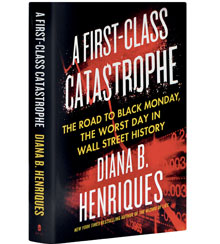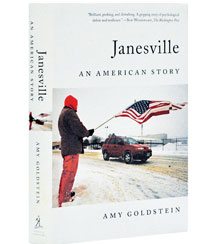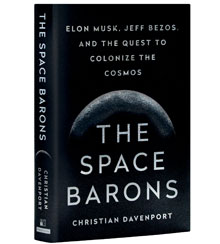Best Business Books 2018: Narratives
American Tales. See also Top Shelf Picks: Best Business Books 2018.
Diana B. Henriques
A First-Class Catastrophe: The Road to Black Monday, the Worst Day in Wall Street History (Henry Holt, 2017)
*A TOP SHELF PICK
Amy Goldstein
Janesville: An American Story (Simon & Schuster, 2017)
Christian Davenport
Space Barons: Elon Musk, Jeff Bezos, and the Quest to Colonize the Cosmos (PublicAffairs, 2018)
In some ways, this year’s best business books told in the form of narratives couldn’t be more different. Diana B. Henriques’s A First-Class Catastrophe: The Road to Black Monday, the Worst Day in Wall Street History explains how the foundations of the financial sector were reshaped in ways that led to the stunning crash of 1987. The best among this year’s crop, by a very narrow margin, it will leave you pessimistic about our ability to learn from the past. Amy Goldstein’s Janesville: An American Story is about the closing, two days before Christmas of 2008, of the General Motors plant that supported the Wisconsin town. It will leave you deeply aware of how dependent our lives are on business. Christian Davenport’s Space Barons: Elon Musk, Jeff Bezos, and the Quest to Colonize the Cosmos describes the catalytic role private companies are playing in exploring space. It will leave you inspired about how business can expand human potential — and maybe even change the universe.
What these books have in common is meticulous reporting. Each story is compellingly told through characters — and each story is larger than the characters. These are all deeply American stories, because what happens in them could not happen, for better and for worse, anywhere else. And all three of this year’s best narratives explore fundamental questions about how business can both make and break the world in which we live.
Crash Course
Our financial system “was held together by invisible strands of trust — the confidence that debts would be paid, trades would be settled, institutions would function, money would circulate,” writes Henriques, a veteran New York Times journalist. “Shred that web of trust, and the system would not hold together.” On Monday, October 19, 1987, the system almost didn’t hold together. The Dow Jones Industrial Average, the major indicator of the market’s health, plunged a sickening 22.6 percent, which is still the largest single-day percentage decline in modern Wall Street history. In today’s terms, that would amount to a Dow loss of about 5,600 points.
The terror in the market was a warning sign about the dangers of high leverage, a fragmented regulatory system, and the growth of huge players such as pension funds that could cause a stampede if they moved as a herd. It was also an early sign that there could be a dark side to financial tools such as futures contracts, which skeptics worried could “distort the way capital flowed through the stock market to finance the American economy.”
Henriques, the author of The Wizard of Lies, the definitive book on the Bernard Madoff scandal, richly populates her newest book with characters. Among them is John Phelan, the chairman and CEO of the New York Stock Exchange, who some seven months before the crash was featured in an article in Investment Dealers’ Digest that discussed how he’d been “warning top officials in the securities industry of a program trading scenario — which he calls ‘financial meltdown’ — that could drive the market down hundreds of points.” Phelan told the publication, “At some point, you’re going to have a first-class catastrophe.” In that same article, Alan “Ace” Greenberg, then the CEO of Bear Stearns, called Phelan’s concerns “totally ridiculous” and added, “Don’t fix things that aren’t broken.”
But as Henriques writes, that belief — that “‘markets cure themselves’ without government interference” — had “firmly taken root in Washington in the 1970s, and it would spread like kudzu over the policy-making landscape for decades.” Even as the 1987 crash percolated, a Goldman Sachs executive named Gary Seevers argued to Congress that market participants were “sophisticated entities, dealing among themselves,” so the best strategy was to “do nothing.”
The crash of 1987 was also an early lesson in how theory and reality could diverge. What could sound better than the idea that you could use futures contracts to insure portfolios against losses? The concept that came to be known as “portfolio insurance” gave the owner the right to sell a portfolio of stocks at a specific price in the future, thereby putting “a floor under any losses the whole portfolio incurred in a stock market decline.” But what if everyone’s program dictated selling simultaneously, and the selling begat more panicked selling? At a secret session of Congress, Phelan testified how important it was to realize that “when everybody wants to leave the room at the same time, it is not possible to get out.”
The biggest lesson of all from the crash — one that would resonate in our own time — is that when the financial system cracks, the motto of “free markets for free men” no longer holds, because the government has to step in. Even before the crash, then SEC commissioner Bevis Longstreth told Congress that “market discipline, which is much in vogue these days, can only assure soundness in an environment where institutions are permitted to fail.” But as Henriques details, in the months leading up to the crash of 1987, the government — namely, the Federal Reserve — had to get involved multiple times to save the system. Henriques writes, “The simple truth was that financial institutions could no longer be allowed to fail — the links among them were [in the words of Longstreth] ‘simply too extensive to prevent one failure from triggering another.’” Somehow, in 2008, that came as a shock.
Company Town
Whereas Henriques foreshadows the 2008 financial crisis, Amy Goldstein’s book deals with its aftermath. As the resulting recession hit, auto companies, which were already struggling with decades of bad decision making, plunged into bankruptcy. Although there was a bailout for the auto companies, there was none for the citizens of Janesville, Wis., who saw their way of life evaporate when, two days before Christmas of 2008, the General Motors plant that had opened on Valentine’s Day in 1923 and survived the Depression, a strike, and more, suddenly closed. Forever.
Janesville is a poignant portrait of how much our communities depend on the success of the businesses that support them. When the plant closed, jobs that existed as part of its ecosystem also disappeared — including those at Lear, which built seats; Logistics Services, which sequenced parts and delivered them to the plant; and Allied Systems Group, which hauled GM vehicles to car dealers throughout the Midwest. Laid-off workers took the jobs of those who used to work at Burger King or Target so that “as middle-class families have been tumbling downhill, working-class families have been tumbling into poverty.” Even as that happened, Janesville’s long-standing charitable efforts, such as the holiday food drive that provided groceries and toys to needy families, also disappeared.
Janesville is a hard book to put down because Goldstein, a Pulitzer Prize–winning longtime Washington Post journalist, tells the stories through such captivating characters. Kristi Beyer and Barb Vaughn, both of whom are laid off from Lear, have had very different lives. But both discover in themselves a fierce competitive spirit as they navigate their way in middle age through the criminal justice program at Blackhawk Technical College and get coveted jobs at the local jail. Then, their stories diverge in shocking ways.
In the fall of 2009, Blackhawk saw a 54 percent surge in students, but Goldstein reports, stunningly, that at least in the time frame of her book, the laid-off workers who went to Blackhawk actually fared worse than the ones who did not. “The people at Blackhawk know a grittier, ground-level truth,” Goldstein writes. “Retraining laid-off factory workers is not easy.”
Goldstein also traces the trajectory of Matt Wopat, who becomes what’s known as a Janesville gypsy — someone who takes a job at another GM plant hours away. It is far from ideal for his family, but Goldstein writes that “every time [Wopat] has rethought the exceedingly hard question of whether he missed a clue, whether he overlooked some narrow passageway that would have led him out of the maze, he came to the conclusion that he had not.”
Janesville also illuminates the yawning gap between the high-flying rhetoric of politicians and the grim reality lived by those on the ground. In 2010, President Obama gave a stirring speech about how his administration had stood by auto workers. “We said yes to the American worker! They’re coming back!” In reality, the person dispatched by the Obama administration to solve the problems of communities like Janesville paid one short and heavily orchestrated visit to the city, quit shortly thereafter, and was not replaced. A harsh report by the Government Accountability Office on the effort noted that no one even kept track of any government efforts to help workers. In 2013, Congressman Paul Ryan, who represents Janesville (his hometown) in Congress, was the keynote speaker at a dinner in the city where “at each place setting is prime rib with hollandaise and, as a party favor, a clear tumbler with green printing that says, ‘We See the Glass More Than Half Full.’” It went unmentioned that the county still had 4,500 fewer jobs than when GM announced it was closing the plant.
Writes Goldstein, “Over a few years, it became evident that no one outside — not the Democrats nor the Republicans, not the bureaucrats in Madison or in Washington, not the fading unions nor the struggling corporations — had the key to create the middle class anew.”
Into Orbit
The third book is, by contrast, a narrative of success. Space Barons, in essence, is about the prospect of business getting things right on a grand scale. After the 1967 Apollo moon landing, the U.S. government, perhaps unintentionally, largely abdicated space. “It was as if Columbus had discovered the New World and no one followed,” writes Christian Davenport, another longtime Washington Post journalist, who covers defense and space.
But in an age of public austerity, a handful of self-made billionaires, including Virgin founder Richard Branson and Amazon founder Jeff Bezos, are betting “vast swaths of their enormous fortunes that they could make space available to the masses,” find new sources of energy, and perhaps even ensure the survival of the human species. “Getting to orbit, that’s just a huge milestone,” Musk says after his company, SpaceX, has successfully launched a rocket into orbit. “There are only a few countries that have done it. It’s normally a country thing, not a company thing.”
Some of the entrepreneurs involved believe there is something uniquely American about this endeavor. And they’re right — whether it’s the glorious ambition driving the whole affair or the occasional self-inflicted wounds. Space can be incredibly dangerous, and a deeply emotional moment in the book comes when a pilot is killed. “The freedom to kill yourself in all manner of stupid ways was part of the American way,” writes Davenport.
Davenport’s story is also rich in characters, such as Andy Beal, a Texas banker billionaire and poker player who poured his fortune into space before deciding that he couldn’t compete with companies that were subsidized by the government. At the center of the tale are Elon Musk and Jeff Bezos, who Davenport ultimately concludes need each other as much as Russia and the United States once did. “Rivalry, it turned out, was the best rocket fuel,” he writes.
Musk and Bezos are similar in some ways. Both have been obsessed with space since childhood and want to recapture the lost glory of 1969, when Neil Armstrong and Buzz Aldrin landed on the moon (Bezos was 5 years old; Musk was 2). “We all have passions,” Bezos tells a group of schoolchildren. “You don’t get to choose them; they pick you. But you have to be alert to them. You have to be looking for them. And when you find your passion, it’s a fantastic gift for you because it gives you direction.”
Both Musk and Bezos have been obsessed with space since childhood and want to recapture the lost glory of 1969, when Neil Armstrong and Buzz Aldrin landed on the moon.
Both are pursuing the “holy grail” — rockets that can dramatically lower the cost of space travel because they can fly, land, and fly again. Both men are willing to rethink everything about space travel. Bezos, in fact, was so willing to start from scratch that his company, Blue Origin, even considered using a bullwhip to launch a space capsule, whereas SpaceX has “an obsession with finding ways to do things cheaply and efficiently, and an almost instinctive contrarian bent that questioned everything — the price, the rules, the old way of doing things.”
But in some ways, the men are very different. Musk’s strategy has been to seek publicity and adopt an aggressive, in-your-face approach to the existing industry, which has even included suing NASA over contracts. SpaceX COO Gwynne Shotwell says that from the beginning, SpaceX’s approach was to “set audacious, nearly impossible goals and [not] get dissuaded. Head down. Plow through the line.”
Bezos, on the other hand, who has funded Blue Origin by selling about US$1 billion of Amazon stock each year, has pursued a path of “obsessive, disciplined silence.” The company’s motto is “Gradatim Ferociter,” which translates as step by step, ferociously, and Davenport writes that “perhaps none of its symbols was more important than a pair of turtles reaching up toward the stars — an homage to the winner of the race between the tortoise and the hare.”
Despite some massive failures and continuing questions over the achievability of Musk’s grand goals — namely, flying human passengers to Mars by 2024 — by some important measures, the entrepreneurs in Space Barons have already been hugely and importantly successful. They’ve revitalized the interest in space. Investment dollars are now flooding into the industry, and at Purdue University, applications for the undergraduate aerospace engineering program have jumped 50 percent in recent years.
When SpaceX successfully brought a rocket back to landing, the company erupted into a cheer of “USA.” “It was perhaps an odd choice for a cheer — this was the feat of a single, private company, not a nation,” Davenport writes. “But in the unbridled exuberance of the moment, it also felt right, as if what they had accomplished extended far beyond the company’s headquarters.”
Indeed, Space Barons is an inspiring reminder that although business gone wrong can leave wreckage in its wake, business done right leads humanity forward in a way that goes far beyond profits.
Author profile:
- Bethany McLean is the coauthor of The Smartest Guys in the Room and All the Devils Are Here. Her most recent book is Saudi America: The Truth About Fracking and How It’s Changing the World (Columbia Global Reports, 2018).








